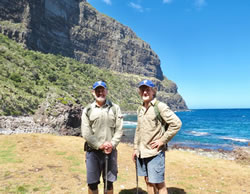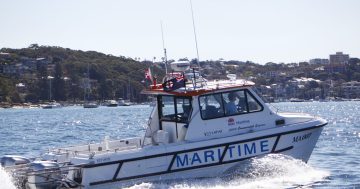 Two senior scientists from the Department of Planning, Industry and Environment (DPIE) have been honoured for their work to safeguard the future of Lord Howe Island’s unique wildlife.
Two senior scientists from the Department of Planning, Industry and Environment (DPIE) have been honoured for their work to safeguard the future of Lord Howe Island’s unique wildlife.
Nicholas Carlile (pictured right) and Terry O’Dwyer (pictured left) have been named joint winners of the NSW Premier’s Prize for Science and Engineering for Innovation in NSW Public Sector Science and Engineering.
In a statement, the Department said the two were key members of an ambitious, multi-Agency rodent eradication program on Lord Howe Island.
“O’Dwyer said that before the eradication, rodents posed an existential threat not just to individual species, but to the entire (Lord Howe Island) ecosystem,” DPIE said.
“The introduced pests exploded in numbers reaching as many as 300,000, invading every ecological niche from the beaches to the precious cloud forests on the summits of Mount Gower and Lidgbird,” it said.
“Rats devoured crabs, insects, seeds, seedlings, eggs and chicks of both sea and land birds that led to five endemic bird extinctions.”
DPIE said the Lord Howe Island Rodent Eradication Program (LHI REP) took around 15 years of detailed research and planning, involved a baiting program and a captive management plan to protect birds from ingesting baits or eating dying rodents.
The Department said the Eradication Program began in May 2019 and ran through to November 2019.
“In the winter of 2019, Carlile and O’Dwyer, with a team from Lord Howe Island Board, captured half of the island’s currawongs and 85 per cent of the iconic woodhens,” it said.
“While these species were safely in captivity, baits were laid using helicopters in the island’s remote areas and enclosed bait stations in and around the inhabited community areas
DPIE said Mr Carlile and Dr O’Dwyer walked for over 560 hours around the island during the active baiting period, searching and monitoring for any injured birds that may have ingested baits.
It said that in the 18 months since the eradication program ended, Lord Howe Woodhen numbers had surged dramatically from 200 to over 600, and the threatened birds were once again a common feature across the island.



